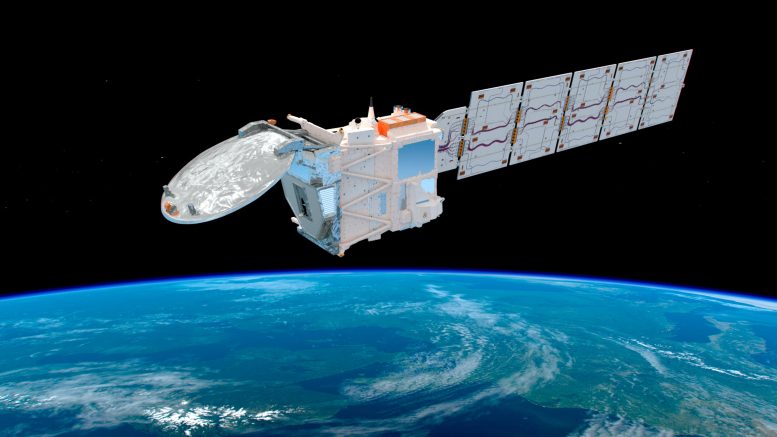
ESA’s EarthCARE mission carries a suite of instruments to answer some critical scientific questions related to the role that clouds and aerosols play in reflecting incident solar radiation back out to space and trapping infrared radiation emitted from Earth’s surface. Although clouds play an extremely important role in atmospheric heating and cooling, they remain one of the biggest mysteries – in fact the least understood factor – in our understanding of how the atmosphere drives the climate system. Credit: ESA/ATG medialab
EarthCARE, the European Space Agency’s advanced satellite mission, is set to revolutionize our understanding of the climate system by exploring the interactions between clouds, aerosols, and radiation.
Dedicated to delivering a wealth of new information on exactly how clouds and aerosols affect Earth’s climate, ESA’s EarthCARE satellite has had the chance to show off prior to engineers embarking upon the careful task of packing it up for its journey to the launch site in the US.
Carrying four different instruments, this remarkable satellite is the most complex of ESA’s Earth Explorer missions – missions that return key scientific information that advances our understanding of how planet Earth works as a system and the impact that humans are having on natural processes.
Addressing the Climate Crisis
With the climate crisis increasingly tightening its grip, the Earth Cloud Aerosol and Radiation Explorer, or EarthCARE for short, was developed to shed new light on the complex interactions between clouds, aerosols, and radiation within the Earth’s atmosphere.
Energy in the atmosphere is a balance between incoming radiation from the Sun, which heats the Earth system, and outgoing thermal radiation, which cools Earth. Although it is known that clouds play an extremely important role in atmospheric heating and cooling, they remain one of the biggest uncertainties in our understanding of how the atmosphere drives the climate system.
Clouds and, to a lesser extent, aerosols reflect incoming solar energy back out to space, but they also trap outgoing infrared energy. This leads to a net effect of either cooling or heating. In addition, aerosols influence the life cycle of clouds and so contribute indirectly to their radiative effect.
EarthCARE’s set of four state-of-the-art instruments will work together to provide a holistic view of complex interplay between clouds, aerosols, and radiation to yield new insight into Earth’s radiation balance against the backdrop of the climate crisis.
Pre-Launch Preparations
With liftoff slated for May on a SpaceX Falcon 9 rocket from the Vandenberg Air Force Base in California, EarthCARE has been going through the last round of tests and meticulous checks in Germany.
Now ready to be declared fit to travel, the two-tonne EarthCARE satellite has been standing proud on display in a cleanroom at Airbus’ facilities in Friedrichshafen.
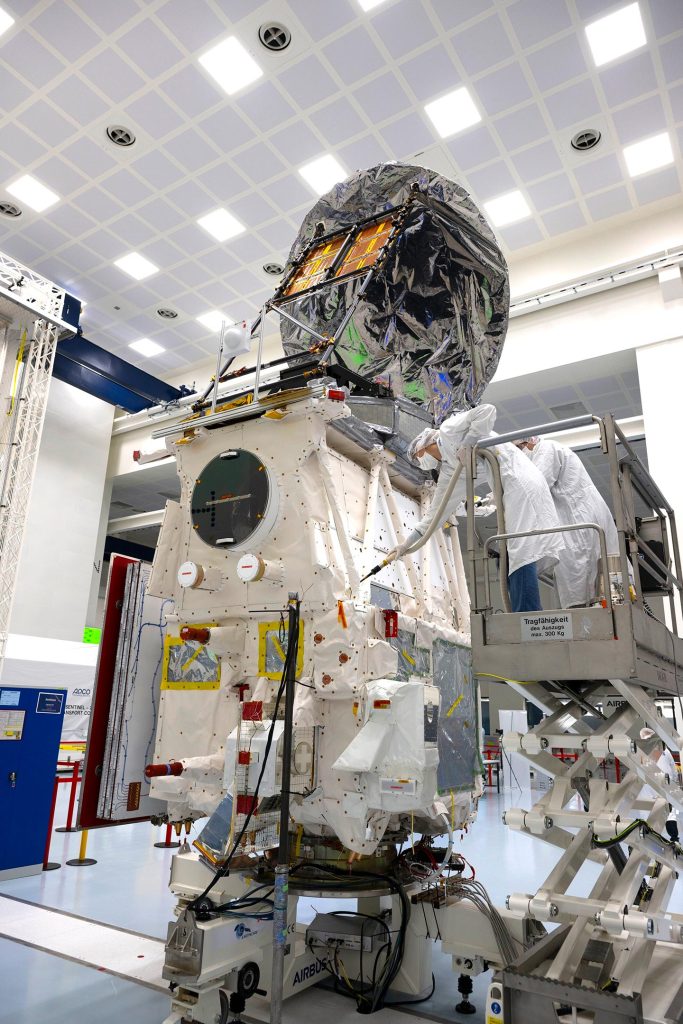
One of the last jobs to do before ESA’s EarthCARE satellite is packed up for shipment to the US launch site is to make sure it is very clean. The photograph shows engineers carrying out this important task. The satellite has spent the last few months at Airbus’ facilities in Friedrichshafen, Germany, undergoing the last checks the satellite has in Europe. Credit: ESA–S. Corvaja
ESA’s EarthCARE Project Manager, Dirk Bernaerts, said, “It’s great to see EarthCARE in all its glory and I’m extremely proud of what ESA, JAXA, and our industrial partners have achieved in developing this extraordinary mission.
“As a hugely complex mission, it has been a rather long road, but it now comes at a critical time in the development of global climate models that are starting to resolve cloud convection at kilometer scales – we talk about it now being ‘the age of convection’.
“EarthCARE is certainly poised to make an important contribution to complicated climate models and numerical weather prediction.”
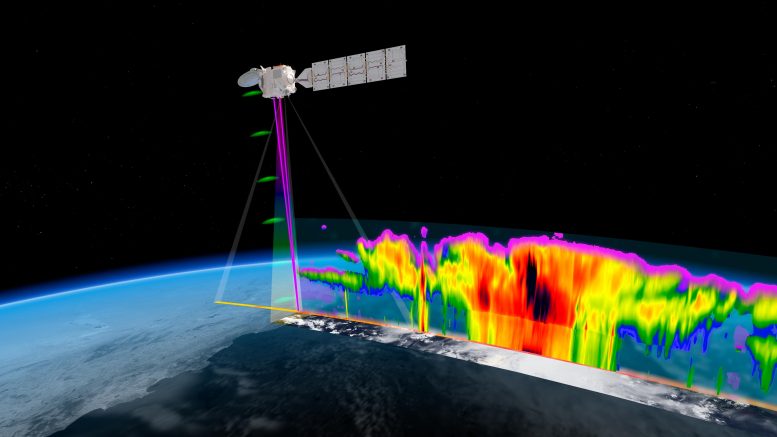
EarthCARE’s unique set of four instruments provides a holistic view of the interplay between clouds, aerosols, and radiation.
Its cloud profiling radar provides information on the vertical structure and internal dynamics of clouds, its atmospheric lidar provides cloud-top information, profiles of thin clouds and aerosols, its multispectral imager provides a wide-scene overview in multiple wavelengths, and its broad-band radiometer measures reflected solar radiation and outgoing infrared radiation.
The fact that these different measurements are all taken at the same time allows scientists to better understand Earth’s radiation balance. Credit: ESA/ATG medialab
Collaborative Achievements and Contributions
ESA’s Director of Earth Observation Programmes, Simonetta Cheli, commented, “EarthCARE will soon add to our growing family of pioneering Earth Explorer research missions. So far, all these missions have exceeded their scientific goals and expectations – and I fully expect EarthCARE will follow suit.
“Although EarthCARE is an ESA mission, we pay special thanks to the Japan Aerospace Exploration Agency, JAXA, which has supplied the cloud profiling radar, one of the satellite’s key measuring instruments.”
JAXA’s Vice President, Koji Terada, added, “Despite the mission being proposed as concept over 20 years ago, EarthCARE is more relevant than ever. I am deeply impressed that the mission is based on such excellent and visionary science requirements. We are very proud to offer the cloud profiling radar for the mission.”
Technological Marvel and International Cooperation
The satellite’s cloud profiling radar provides information on the vertical structure and internal dynamics of clouds, its atmospheric lidar delivers cloud-top information and profiles of thin clouds and aerosols, its multispectral imager offers a wide-scene overview in multiple wavelengths, and its broadband radiometer measures reflected solar radiation and outgoing infrared radiation.
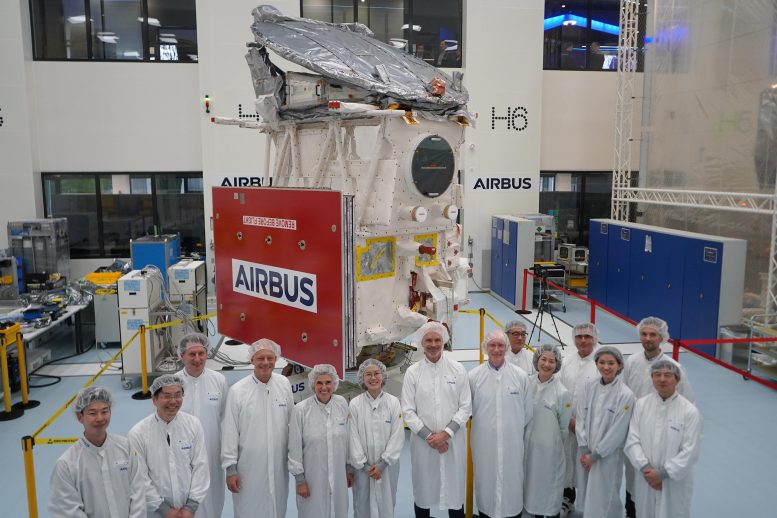
Group photo in front of ESA’s EarthCARE satellite in the cleanroom at Airbus’ facilities in Friedrichshafen, Germany. Credit: ESA
Airbus EarthCARE Project Leader, Maximilian Sauer, said, “EarthCARE took 15 years to develop with experts involved from over 15 countries in Europe as well as Canada, US, and Japan. And thanks to this hard work we have a satellite that is set to enhance climate models.
“This is also a great achievement for colleagues from three different Airbus sites and for more than 40 subcontracting companies that have been involved.”
Walther Pelzer, Director General of the German Space Agency, DLR, noted, “The EarthCARE satellite was built in Germany. Furthermore, a lot of German companies and scientific institutions are involved in the mission. EarthCARE highlights Germany’s leading position in the international Earth observation landscape.”

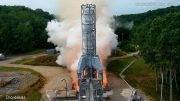


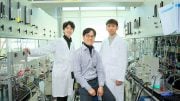
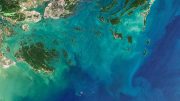



They state, “Although it is known that clouds play an extremely important role in atmospheric heating and cooling, they remain one of the biggest uncertainties in our understanding of how the atmosphere drives the climate system.” They use this lack of knowledge as justification for their expensive set of sensors. They then state, “With the climate crisis increasingly tightening its grip,…, … EarthCARE …, was developed to shed new light on the complex interactions between clouds, aerosols, and radiation within the Earth’s atmosphere.” The words they use imply an existential crisis that they know the cause of, but lack sufficient data to make a compelling case for.
An unstated assumption is that while the platform is making nadir measurements directly or nearly under the sensors, the rest of the globe is experiencing similar conditions, and that what they are obtaining are representative sample measurements. This isn’t the case, particularly for the more than 71% of the surface (water) acting as a specular reflector, where the angle of incidence of the incoming light rays determines the reflectivity of the surface. The Bi-directional Reflectance Distribution Function (BRDF) of diffuse reflectors (notably clouds, snow, sand, and vegetation canopies) also varies with the angle of incidence. Something the radiometer will almost certainly miss is the radiation reflected away from the Earth and not back towards the sun. They will, no doubt, obtain useful information. However, they shouldn’t delude themselves or the public into thinking that the information will end the debates. A bigger problem is that none of the extant super-computers can use cloud-energy exchange data at the same spatial and temporal resolution as the rest of the forcing variable are computed with. They will still have to parameterize the, hopefully improved, cloud data.